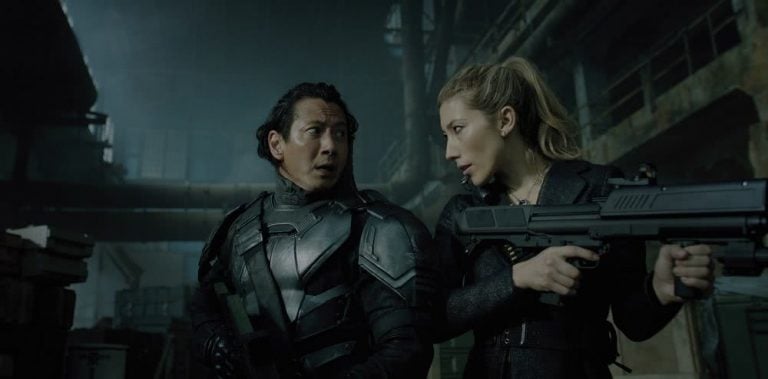Altered Carbon is set in the distant future where human personalities are stored digitally in ‘stacks’ that look like futuristic pogs. Remember pogs? They’re back, in Altered Carbon form. A person can become immortal if their stack remains intact, and when people die in the physical world, their stack is put in a new body, also known as a ‘sleeve’.
For that reason, ‘re-sleeving’ becomes like doing a trade-in on a used car for a new one, but economics, class and religious beliefs dictate how people die or are reborn. Wealthy citizens pay for better sleeves, while poor people have to deal with whatever is available in the public system. If you die in your original body as a kid and you can’t afford a fancy new sleeve, you could be re-sleeved into the body of an 80-year-old. Cloning your original body to re-sleeve into is also a possibility, but it’s crazy expensive. Oh, and if people get murdered they can be re-sleeved to point out their killer, or if their death is an accident they get a new body. And before I forget, artificial intelligence also exists, but they appear as avatars but are considered outdated and lame. Are you exhausted yet?
Once Altered Carbon begins to offer concepts to mull over, the show opts to splatter brain matter over the walls
The Netflix original series, based on Richard K. Morgan’s novel of the same name, pummels the science fiction smarts at play into a pulpy mess. The plot focuses on Takeshi Kovacs (Joel Kinnaman/Will Yun Lee), an elite solider who is re-sleeved and hired by a rich guy (James Purefoy) to investigate the death of himself. Yep, rich people are still massive self-absorbed jerks in the future but the idea is a surreal one: the ability to hire someone to solve your own murder.
Each episode of Altered Carbon lobs up something interesting in a futuristic world that puts digital minds over matter. The major hurdle is wrangling the justification for each piece of technology and the lingo; it’s a decathlon of ideas. Altered Carbon is always setting itself up without progressing the plot, because it gets stuck explaining science fiction jargon without a hope of being saved by its horrible dialogue.
But once Altered Carbon begins to offer concepts to mull over, the show opts to splatter brain matter over the walls. Altered Carbon puts science fiction through the Game of Thrones filter, and favours gratuitous violence and sex over the hard work of establishing the central ideas of the show. There’s a softcore quality to the way the sex scenes are shot and the camera leers at as many boobs as it can. For balance, you do see Kinnaman’s butt, which must have its own agent based on the number of times it appears. Altered Carbon may be science fiction in spirit, but it has the hormones of a 16-year-old pumping through each frame.
Still, the haphazard way people use their bodies in Altered Carbon highlights the way sleeves are treated like old sneakers. Debauchery rules because mortality no longer applies and eternity offers boredom, which is when the worst human impulses emerge. The world of Altered Carbon is in favour of the rich, so they have the most fun at everyone else’s expense. And though there are a few times when the gratuitous nature of the show works to its advantage, it reverts to overkill as the series drags on.
It’s sure to launch a 1000 woke takes but the most fascinating part of the show is that Kinnaman, a white actor, is playing an Asian character originally played by Lee in flashbacks. Despite what you think of the casting – Lee’s performance is vital to establishing the character, but given he gets much less screen time, I can understand why people will be angry – the show does explain how people can be put in sleeves against their will. Altered Carbon is more intuitive about what this decision says regarding the setting, rather than the horrid whitewashing most recently found in the blockbuster adaptation of Ghost In The Shell.
https://www.youtube.com/watch?v=dhFM8akm9a4
Takeshi Kovacs is a witness to a world he didn’t want to be a part of, experiencing it via a white body, and there’s a rage in Kinnaman’s performance that builds on Lee’s work. Altered Carbon is reminiscent of Cloud Atlas in the way a soul can transcend the physical trappings of a body, but it has the technology to explain how it’s possible. Once you throw in the way religious questions, the nature of the ‘stack life’ and the right to die, there’s a lot more to consider about how this world is constructed… But then more boobs get in the way.
There are cool ideas within Altered Carbon – you just have to sift through the all the blood, splatter and flesh piled on top. The tech noir feel of Altered Carbon is a tiny saving grace, and there are enough trench coats for it to hang heavily on Blade Runner as a reference point, but that seems like the easiest shortcut to take.
All that said, like Ridley Scott’s iconic film, Altered Carbon, at its core, is a private eye tale with a mystery that’s enticing enough to make it worth binging if you’ve got nothing left to watch. The constant shift from clever science fiction and schlock is jarring, and Altered Carbon limps though 10 episodes that are made to feel like 20.
Altered Carbon premieres on Netflix this Friday February 2. For more TV reviews, read our thoughts on Netflix’s The Good Place, here.

































